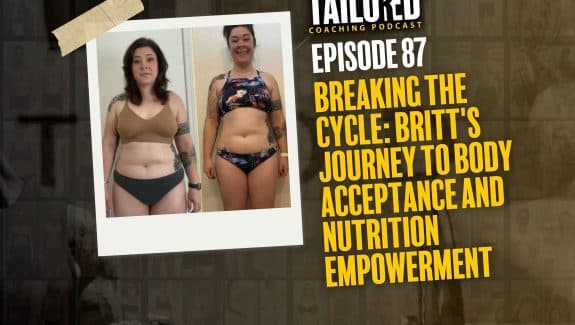Cortisol… one of the most feared hormones, also one of the most misunderstood. It’s also a double edge sword; because sometimes we want and need it… other times we hate and avoid it, because it can cause more stress and less fat loss.
So which is it?
A good hormone we need in order to be productive, perform harder, and allow our body to actually breakdown-stored nutrients (fats, carbs, protein)?
Or a stress-based hormone that causes an overstimulated nervous system, which pushes us further away from our fat loss goals and closer towards an anxiety-ridden lifestyle?
You’re going to absolutely hate my answer… IT’S BOTH.
Sorry, but that’s the reality here.
Cortisol is a hormone we need to pay attention and try to create a balance for, so that we can utilize its powers when they’re needed and avoid over-production of it, which can lead to regression of results.
WHAT IS CORTISOL?
Let’s start with defining what it is, so you have a fundamental understanding of what it does in the first place:
“Cortisol is a steroid hormone that regulates a wide range of processes throughout the body, including metabolism and the immune response. It also has a very important role in helping the body respond to stress.”
Reading that definition, this double edged sword theory begins to make a bit more sense.
Think about it, if a building you’re in explodes and you have to run, jump, and escape as the heat of the flames creep up behind you (scene from Die Hard) – cortisol increases, your sympathetic nervous system kicks on, adrenaline is produced, and your body begins to mobilize stored energy (fat or glycogen); all as a sequence of events so you can jump, lift, sprint, explode, etc…
So in more simple terms, it’s a stress based hormone that allows energy mobilization. This means it is literally the leader in a hormonal process that converts stored energy into fuel for performance.
CORTISOL AND ENERGY PRODUCTION
Cortisol is a hormone that allows us to actually be stronger and more explosive in our training. This is also why controlling it can be advantageous, because if you allow it to raise going into training, you’ll likely be able to perform harder in the acute setting.
It’s also the hormone that gets us up in the morning, rising and waking us up from an overnight slumber. This is part of our natural circadian rhythm and body clock, so if your cortisol spikes around 4am in the morning it actually means you’re in a healthy hormonal cycle. It means cortisol is doing its job, bringing you out of the short term hibernation your body demands (sleep).
The unfortunate truth in today’s society is that blue light stimulation and all the other aspects of a normal day-to-day lifestyle cause an overstimulated nervous system. This leads to constant elevation of cortisol, a sympathetically driven CNS all day, and a circadian rhythm that is far from on time.
CORTISOL AND THE THYROID
Cortisol is also a hormone that works hand in hand with the thyroid, arguably the “control center” of the endocrine system.
The thyroid is an extremely important hormonal gland because it literally affects nearly every cell and other hormone in the human body. Sadly, more than 12% of Americans in the US have thyroid dysfunction (this is what’s known and reported, but it’s likely the true number is higher).
My good friend and colleague Dr. Jade Teta understands and explains the relationship between cortisol and the thyroid well:
“Another dual action of cortisol is how it interacts with the body’s main metabolic fat burning engine, the thyroid gland. Cortisol and the catecholamines sensitize thyroid receptors. So low cortisol can also lead to low thyroid activity. High cortisol blocks the normal conversion of inactive thyroid (T4) into active thyroid (T3). So, like Goldilocks, you don’t want cortisol too low or too high, but just right.”
So again, this just reiterates the fact that we want to control our body clock (circadian rhythm) properly, allow cortisol to be produced at times we need it, and blunt or down regulate it at times we actually do not need it.
With this knowledge, we can also claim that cortisol indirectly allows us to have a fast or slow metabolism. Like he said, the thyroid gland is one of our fat burning machines – because a healthy thyroid leads to a well-functioning metabolic rate. Dysfunctional cortisol levels, therefore, can lead to a dysfunctional metabolism.
CORTISOL AND INSULIN
Cortisol also affects insulin (you may read that first line more than expected in this article, because a lot is affected by cortisol).
Its relationship with cortisol is inverse, because it down regulates when insulin is spiked up from ingestion of carbohydrates (or protein, to a degree).
Insulin is similar to cortisol in the sense that it’s a double-edged anabolic sword. By that I mean it’s highly anabolic and we need it in order to build serious muscle mass, it’s exactly why enhanced bodybuilders inject it directly into their bloodstream.
But if insulin is constantly elevated there can be some struggles with staying lean and/or burning more body fat. This is argued in the evidence-based community because there’s a lot of research to show that if calories are controlled and the individual is in a deficit, insulin has zero effect on body composition results.
The argument then becomes calories partitioning, long-term effects, health, etc… but this is not a time or place for an insulin argument (it’s a balance that needs to be found, anyway).
So how can we use this information about insulin causing down regulation of cortisol, to our advantage?
You can purposefully spike insulin at times that your cortisol is elevated and you need to control it. This will help you keep stress low, recovery high, and muscles growing.
In fact, there’s been evidence from research done on trainee’s ingesting carbs during and after a hard training session that showed the suppression of cortisol levels lead to more cross-sectional muscle tissue growth. This is a result proving that suppressing cortisol at the right times can actually (literally) build muscle mass. Add tot hat, there’s TONS of anecdotal evidence from my coaching and other experts like Christian Thibaudeau, John Meadows, Mark Coles, and many others proving that managing cortisol around training, via nutrition, helps muscle growth.
But let’s get away from the peri-workout window and talk about high and constant daily stress levels in the average American, due to overly elevated cortisol levels.
These individuals can be sure to include adequate protein and carbohydrates throughout their meals in order to keep cortisol under control and actually manage stress levels (and body composition changes) even better.
CORTISOL, HUNGER AND CRAVINGS
You guessed it; cortisol affects MORE of the processes our bodies go through on a daily basis – specifically those processes we concur when in a deficit or dieting phase.
Cortisol, by ways not completely understood or fully discovered in the literature yet, negatively impacts, or accentuates, cravings.
This means when we’re on a diet or fat loss journey, controlling stress and cortisol levels is massively important to avoid cravings and binge episodes.
Cortisol and stress in general can cause cravings for more palatable (think foods with combinations of fats and sugars/carbs) foods, foods that are very calorie dense typically. It does this by shutting off the goal oriented centers of the brain and ramping up the reward centers of the brain – my guess is that there is a big effect on dopamine and serotonin levels during this process, as well.
But all of this makes sense, if you think about what sleep deprivation or a bad break up does to you.
Studies show sleep deprivation of even just a couple hours can significantly increase the desire for more calories, sugar and other “non-diet” foods. Basically anything you’re trying to restrict, becomes much harder to restrict, and in the studies they found more fat gain in those with sleep deprivation.
We don’t need a study for the bad break up scenario, just think about the last time you got dumped and wanted to pound down a tub of Ben and Jerry’s – emotional stress ⇒ cortisol raises ⇒ cravings increase ⇒ junk food destroyed.
When it comes to hunger, cortisol essentially shuts down the hormonal signals our brain receives to help it stop consuming food. I’ll refer to my friend Jade again for this one:
“The command and control center of your metabolism is an area of the brain called the hypothalamus. This is the center of your metabolic sensor/thermostat. This area needs to hear the signals being sent by the peripheral hormones like leptin and insulin, both of which shut down hunger in normal circumstances. Chronically elevated cortisol levels cause irritation in the hypothalamus leading to down regulation of hormone receptors inducing hormone resistance.”
In other words, if cortisol is chronically elevated your body will not “hear” the signals needed in order to know it’s satisfied and it becomes very hard to control your hunger. Which makes sense from a survival standpoint, but for losing fat in today’s world… not the best situation for adhering to a diet plan.
CORTISOL AND FAT LOSS
Ok, now let’s get to the reason you’re really here – learning how to manage cortisol so you can burn MORE fat, not stop the fat loss from ever occurring.
So how do we do it? How do we master the cortisol balance?
We have to control it.
We don’t need eliminate its production and we definitely don’t need to exaggerate its production, we just need to manage it in a way that it’s helping us train harder, mobilizing energy during our sessions, but not staying elevated after the fact because that’s how we lead down the path of low recovery, less muscle, and more fat accumulation.
Here’s your cortisol checklist;
Follow these and you’ll utilize cortisol for it’s advantages while avoiding it’s detriments:
→ Get 7-8 hours of sleep per night and if you cannot get more than 6 hours per night, make up for it on your weekends by adding in a float tank or getting 9-10 hours each nigh on the weekend. The point here is simple; we need sleep to keep our circadian rhythm in check and to manage our cortisol levels properly.
→ Manage stress, which is easier said than done BUT it’s worth adding in here because the more you stress about the uncontrollable and get anxiety over things that aren’t worth your energy – the higher and more consistently your cortisol levels will be elevated and as you’ve learned today, this leads to a slower metabolism, dysfunctional thyroid, and uncontrollable hunger.
→ Prioritize peri-workout nutrition; meaning your nutrient timing around your training. This comes later on the totem pole of fat loss, compared to calories and macros (check out the Nutrition For Fat Loss Series for more on the Hierarchy of Importance), but it still needs to be a focal point if you have a stressful lifestyle or are looking to limit the negative impact that stress may have on your physique. I would highly suggest reading our blog on nutrient timing for a full rundown, but in summary – eat carbs and protein pre and post workout, with the additional intra-workout carb shake if your goals are more centered around building muscle than anything else.
→ Remember that cortisol isn’t a negative hormone; it’s just a hormone that needs some attention so that you can balance your levels out properly. This usually means allowing it to rise in the morning, occasionally encouraging it pre/during workouts, and attempting to lower it after workouts to promote better recovery.
→ Meal frequency can allow you to better control your cortisol levels to avoid overproduction or chronic elevation. This is why intermittent fasting is not a great strategy for those who have generally higher stress levels or very intense training sessions. Instead, eat between 4-6 meals per day while balancing your macros across those meals to consistently blunt that cortisol response from being elevated all day long. The brain also needs glucose to be productive, so there’s a good argument to be made for consuming carbs throughout the day to keep your brain firing on all cylinders.
→ Undulate your training intensities. This is something I will take credit for titling, because I haven’t heard many others speak of it in this fashion, but I’m definitely not the first to design weekly training programs in this fashion. The goal with this is to push intensity hard on some sessions and promote a lower intensity at other times. If we stay at a high intensity at every session, we keep our body in the sympathetically driven neurological system constantly – leading to more stress, cortisol, and breakdown. But this also leads to less recovery and muscle growth. By undulating (waving) your intensities up and down throughout the week you will perform better during those hard sessions, save yourself from needing so many deload weeks, and optimize cortisol management.
→ Cooldown post training. Besides post workout nutrients, helping spike insulin and blunt the cortisol response from training, we can also promote a parasympathetic nervous system tone by going on a slow walk post workout or implementing some deep breathing while lying flat on your back. Either way, we’re simply trying to calm the nervous system down so that it can begin to recover.
→ Just chill out! Lastly, simply be calm and happy. Sounds to good or simple to be true, but studies show psychological relaxation is one of the best promoters of recovery from training. We covered it heavily in the recent recovery blog, but the point is that we as humans need to seek happiness, physical touch, and relaxation more often if we want to manage cortisol levels and have an optimal body composition.























































































































































































































































































































































































































































































